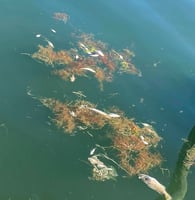One of the most pressing issues that we face today is the phenomenon of red tide. Red tide is algae...
Red Tide: Its Causes and Effects on the Environment
 Understand the Issues Facing our Oceans, Bays, and Canals.
Understand the Issues Facing our Oceans, Bays, and Canals.
Red Tide is a phenomenon we will discuss in this article. Its causes and effects on our marine environment will be examined.
We will explore ways to prevent Red Tide. We will also work on reducing Red Tide's harmful outbreaks and blooms. Lastly, we will aim to minimize the damage it causes.
What is Red Tide?
The natural phenomenon "Red tide" Occurs when phosphorus and nitrogen levels in the water rise and temperatures are warm.
These items are the key factors that allow algae to bloom rapidly in the water. The most noticeable “first” impact is the discoloration of the water. The water takes on a reddish-brown hue.
Phytoplankton or microalgae are responsible for this phenomenon. They are similar to terrestrial plants, requiring sunlight for photosynthesis to thrive and grow.
The last 25 years have seen a lot of water runoff and dumping. This has impacted our saltwater bays, Gulf waterways, and oceans. The environmental impacts stem from increased amounts of phosphorous, nitrates, nitrogen, and other organic matter.
Two major sources of pollutants are fertilizer from residential, commercial, and agricultural operations and wastewater treatment plants. Wastewater treatment plants pump millions of gallons of treated and untreated waste into ecosystems.
These microscopic organisms are found in all marine environments and can rapidly reproduce under certain conditions.
Algae can reproduce rapidly in warm temperatures, increased sunlight, and abundant nutrients. This rapid reproduction of algae forms an algal bloom.
The color of the bloom can range from green to red, depending on the type of algae involved. Red tides have been known to last for days, weeks, or even months.
The effects of red tides can be devastating to the environment. It can cause the death of fish, shellfish, and other marine life by depleting oxygen levels in the water. It can also block sunlight from reaching seagrass beds, leading to their death. In addition, red tides can also produce toxins that are harmful to humans and other animals if ingested.
It is often associated with a red tint in the water, though this is not always true. It typically occurs in coastal areas and is not always harmful. However, certain types of algae bloom can release toxins into the water, causing harm to marine life and humans.
The term "red tide" is unrelated to tides. Rather, it is caused by an overgrowth of microscopic algae called phytoplankton. While most phytoplankton species are harmless, some can produce harmful toxins affecting the environment and human health.
Types of Algae Bloom that Cause it
Several types of algae bloom can cause it, including Karenia brevis, Dinophysis spp., and Alexandrium spp. Karenia Brevis is the most common algae that cause it in the Gulf of Mexico.
It produces a toxin called brevetoxin, which can cause respiratory problems in humans and kill marine life. Dinophysis spp. and Alexandrium spp. are common in the Atlantic and Pacific Oceans and can produce toxins that cause paralytic shellfish poisoning.
The Effects on the Environment
It can have devastating effects on the environment. The toxins produced by harmful algae can kill fish, sea turtles, dolphins, and other marine animals. The dead animals can then wash up on beaches, causing a foul smell and a human health hazard. The toxins can also accumulate in shellfish, making them unsafe for human consumption.
Additionally, it can lead to oxygen depletion in the water, which can cause further harm to marine life. This can lead to the formation of dead zones in the water, where no marine life can survive. It can also lead to the loss of seagrass beds, critical habitats for several marine species.
The Impacts on Marine Life
Red tide can have severe impacts on marine life. The toxins harmful algae produce can cause respiratory problems, paralysis, and death in fish, sea turtles, and other marine animals. The toxins can also accumulate in the tissues of these animals, making them unsafe for consumption by humans.
The death of marine life due to red tide can lead to biodiversity loss in the affected areas. This can cause a ripple effect on the ecosystem. Other species that depend on the affected species for food or other purposes are also affected.
How it Affects Human Health
Red tide can also have adverse effects on human health. The toxins harmful algae produce can cause respiratory problems, such as coughing, wheezing, and shortness of breath. These effects are more severe in people with pre-existing respiratory conditions, such as asthma.
Moreover, consuming shellfish contaminated with red tide toxins can cause paralytic shellfish poisoning, which can be fatal. Symptoms of paralytic shellfish poisoning include tingling or numbness in the mouth and extremities, dizziness, and difficulty breathing.
Monitoring and Controlling
Monitoring and controlling red tide is critical to mitigating its harmful effects. Scientists use various methods to monitor the growth of harmful algae, including satellite imagery, water sampling, and laboratory analysis. This allows them to predict red tide and issue advisories to the public.
Controlling the growth of harmful algae is challenging since it is a natural phenomenon. However, several methods can be used to reduce the impact of red tide. One method of controlling harmful algae is using clay to bind the toxins they produce.
Another approach is using biological controls, for example, by introducing predators that feed on harmful algae.
Finally, physical barriers can prevent the spread of harmful algae.
The Economic Impact
Red tide can have a significant economic impact on coastal communities. The loss of marine life due to red tide can lead to a decline in the fishing industry. This industry is an essential income source for many coastal communities. The closure of beaches due to red tide can also lead to a loss of tourism revenue.
Moreover, the cost of monitoring and controlling red tide can be significant. Using clay to bind toxins from harmful algae is expensive, and introducing biological controls requires extensive research and testing.
Ways to Prevent Red Tide and Reduce Its Harmful Effects
Preventing red tide is challenging, and Precision Marine Construction Inc. is developing advanced dredging technology and eco-friendly docks and seawalls. However, several measures can be taken to reduce its harmful effects. There are several ways to reduce water pollution.
- One is to reduce nutrient runoff from agricultural and urban areas.
- Reduce the discharge of untreated sewage into the water.
- Regulatory changes require more stringent treatment for wastewater treatment plants and stormwater infrastructure.
- Finally, reducing the use of fertilizers and pesticides can also help.
- Capturing water runoff before it enters the waterways and removing the nutrient levels.
Additionally, educating the public about the harmful effects of red tide can help reduce its harmful effects. The public must be made aware of the importance of protecting the environment.
"Supporting research into the causes of the red tide" can help reduce its impact. Developing new monitoring and control methods are also important.
Conclusion – The Importance of Understanding and Addressing Red Tide
In conclusion, red tide is a natural phenomenon that can severely impact the environment, marine life, and human health. Understanding the causes and effects of red tide is critical to mitigating its harmful effects. For more information or what you can do to contribute, contact the professionals and Precision Marine Construction Inc.
Monitoring and controlling red tide, reducing nutrient runoff, and educating the public can all help reduce the impact of red tide. Protecting the environment is critical to ensuring our oceans' and coastal communities' health and sustainability.




Blog comments